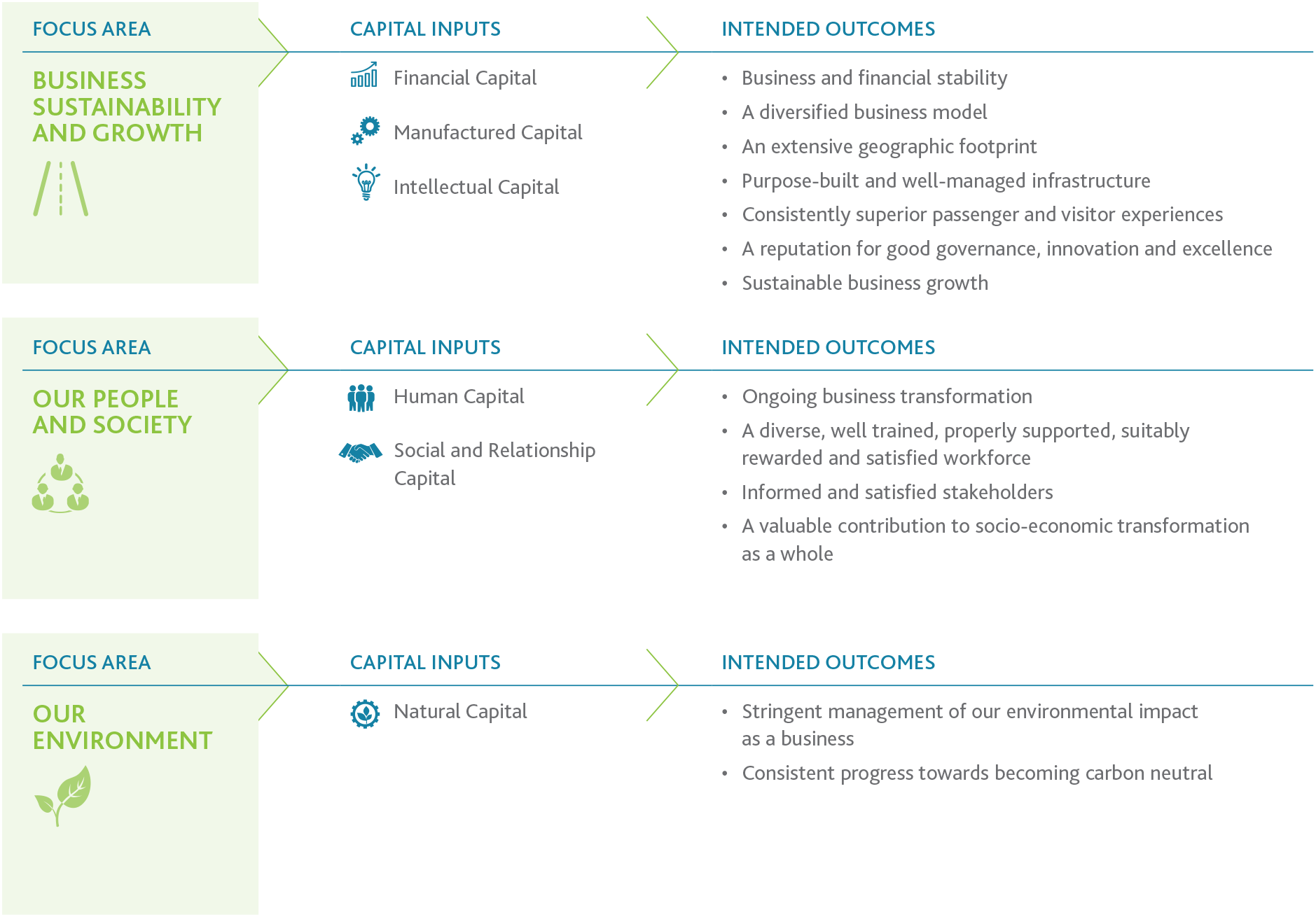OUR STRATEGY
CONTEXT
During the course of the previous reporting period, we undertook a full review of our Strategy 2025 in direct response to the impact of the COVID-19 pandemic.
The resulting Recover and Sustain Strategy and revised Financial Plan provided a framework to guide us through this unprecedented period in our business.
They allowed us to immediately undertake stringent measures to manage working capital and to limit both operational and capital expenditure, as well as to define a way forward over three timeframes from 2021 to 2030.
The strategy nevertheless remained centred around our three core pillars: Run Airports, Develop Airports and Grow Footprint. These define our reason for being as an organisation and give expression to our key areas of strategic focus.
OUR STRATEGY AT A GLANCE

Within this context, the Recover and Sustain Strategy involves the diversification of our aeronautical business model to include new and enhanced service offerings, the review of airport authority functions that have previously been outsourced to external providers, and an intensified focus on airport development to create larger and more diversified economic hubs with airports at their centre.
INITIATIVES DURING THE REPORTING PERIOD
During the 2022 reporting period, we went on to develop a detailed corporate plan and more specific strategies and models that will enable us to implement our objectives and be more flexible and responsive in the short, medium and long term. This process began with the development of a comprehensive Growth Strategy, which was designed for implementation during the second and third periods defined in the broader Growth and Sustain Strategy. This will be supported by a number of strategic initiatives intended to grow our aeronautical revenue, enhance non-aeronautical revenue and generate non-core revenue.
At a macro level, we developed a new ACSA Global Strategy in order to further South Africa’s foreign and bilateral relations in trade, tourism and air transportation; contribute to the broader continental focus on airport development and management; endorse regional economic integration; and maximise the potential benefit to the Group of the African Open Skies initiative.
This is enhanced by more outcomes-specific strategies, plans and models designed to provide the appropriate organisational focus and capacity for effective implementation.
These include a revised Capability Model, a revised Governance Framework and Operating Model, a revised HR Strategy, an updated ITC Strategy and a new Innovation Strategy, all providing a framework to take us forward in as we recover from the COVID-19 pandemic.
Customer-facing strategies developed during the period included our new Passenger Experience and Mobilisation Strategy, which is intended to attract and mobilise people from rural and township communities to make greater use of the many facilities at our airports and to provide easy and affordable access to air travel. As one of the lessons from the pandemic, we learnt that cargo operations, powered by e-commerce, are more resilient than passenger travel in times of crisis and we have therefore developed and adopted a new Cargo Strategy.
In line with these strategies and our focus on developing non-aeronautical revenue, we also developed an Aerotropolis Strategy. This puts in place plans to develop three aerotropolis installations and six smart airport cities, which will facilitate infrastructure and property development and create economic growth engines for surrounding areas and communities. Together with the implementation of our Innovation Strategy, this strategy will place ACSA firmly on a growth path that will ensure future competitiveness and sustainability.
To support our operations, we developed a new Ground Handling Strategy and a Fuel Strategy, both of which are aligned to the Aerotropolis Strategy. The intention of these – and our overall Operations Strategy – is to facilitate not only a recovery in passenger numbers, but also significant growth in export activities in manufacturing, agriculture, retail, e-commerce, logistics and high-value industries such as mining and beneficiation.
As passenger numbers recover to pre-COVID levels, the implementation of our Aeronautical Revenue strategy will focus on cementing this recovery through route and traffic development, the improvement of operational efficiencies and intermodal connectivity.
Throughout the process of developing our strategies, models and plans, we consulted extensively with key stakeholders – including local communities – as industry and stakeholder alignment is essential to the successful implementation of our strategies.
We also thoroughly reviewed and updated our Socio-Economic Development and Transformation Strategy, which provides a framework for us to contribute towards addressing socio-economic imbalances in society in general.
GOING FORWARD
Throughout the 2023 financial year, we will continue to review our entire strategy suite on a consistent basis in order to adapt to changing circumstances and maximise new opportunities. We are, for instance, in the process of revising ACSA’s Commercial Strategy and of repositioning our Training Academy to be a leading and preferred provider of aviation training. Through partnerships, collaboration, acquisition and amalgamation, we are aiming to ultimately offer access to a single integrated aviation academy.
At customer interface level, we are developing extensive passenger marketing and communications plans to open up access to airport infrastructure and air travel for passengers from historically disadvantaged and marginalised communities. This will be based on an extensive diversification of our services offering and the integration of transportation modes to increase the utilisation of airports.
THE SIX CAPITALS
Using six capital inputs, we add value through innovation, processes, procedures and good governance in order to deliver a range of measurable outputs.
Our Sustainability Framework, depicted in the graphic alongside, is aligned with the International
SUSTAINABILITY FRAMEWORK







